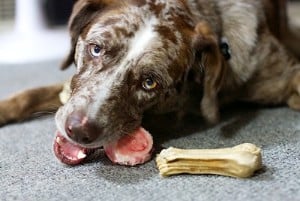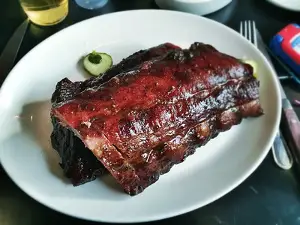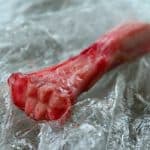
Give a dog a bone? Why, this seems like the most natural thing in the world and many pet owners will gladly throw leftover bones to their beloved companions.
While in most cases the dog will be perfectly fine and grateful for the treat, there’s always the risk that a bone might splinter and do a lot of damage.
Here’s a look at the most common problems caused by bone splinters and which bones are most suitable as a treat for your dog.
Why do dogs chew bones?
There’s a whole debate as to whether or not to give dogs bones. While some vets argue that bones should be off-limits to dogs, experienced dog owners know that there’s usually no harm done if you know what bones are safe. But do dogs really need bones when you have a huge bag of kibble in the pantry?
Yes, they are. Dogs are supposed to eat meat and bones and have done so for thousands of years… and they’re still around, aren’t they?
Chewing on bones is a natural instinct for dogs, one that needs to be satisfied at least once in while. A dog whose chewing needs are not met might resort to licking his paws or scratching himself until it bleeds.
Chewing bones is a good and natural hassle-free way to keep a dog’s teeth clean and healthy.
Dogs love bones because they offer a lot of good nutrients, including calcium which is good for their own bones. Experts say that one of the main reasons dogs become obsessed with bones is that they lack certain nutrients, although this is not always the case.
Bones provide mental stimulation for dogs. Their regular chow is always the same if your dog is on a commercially-available food diet. A bowl of kibble is just like the next one, there’s nothing interesting or vaguely surprising about it.
On the other hand, working their way around a bone, polishing every last bit of meat or sucking them dry of that juicy marrow, now that’s fun. It’s a challenge that puts the dog’s brain to work and a job well done is very rewarding. Just like you feel when you try to scoop out that last bit of ice cream.
Why do dog bones splinter?
This is indeed a big problem, but one thing you need to keep in mind is that not all types of bones pose the same risk. The most dangerous are chicken and bird bones which are small and less dense than pork or beef bones. Birds and poultry have light bones, full of air sacks. They need light bones to fly. Well, chickens don’t fly, but you get the idea. As such, these bones can easily splinter when the dog chews on them. This can also happen with small pork bones, by the way, so you need to be careful with those, too.
What are the symptoms of bone splintering in a dog?
Many dog owners will tell you there’s absolutely no problem if you give bones to your pet, but vets know different and there are plenty of horror stories they can share.
Splinter lodged in the esophagus
The most immediate danger is that of a bone splinter becoming lodged in the dog’s esophagus and it’s a life-threatening issue, as the dog can choke on it. In this case you should try the Heimlich maneuver right away or your dog might not make it to the vet.
Another possibility is that the bone splinter is small enough to allow the dog to breathe, but it’s still stuck in the esophagus. Some of the symptoms you might notice include
- Gagging
- Trying to retch up
- Excessive drooling
- The dog rubbing his head against the floor trying to get rid of the obstruction
- Restlessness
- General air of discomfort
The first thing you need to do is to open the dog’s mouth as wide as possible and see if you can remove the bone splinter yourself. Don’t worry, by this point your dog will be in too much distress to object to that. However, this not easy and special instruments might be needed, in which case head to the vet straight away.
Can a dog’s stomach digest a bone?
If the bone splinters make it to the dog’s stomach, there are reasons for you to be cautiously optimistic. A dog’s stomach can and in most cases will digest the bone.
The digestive acids are strong enough to dissolve a bone or most of it so it can normally be passed without problems. If you’re worried that the dog’s vigorous chewing caused the bone to splinter, give him a piece of bread to try to coat the sharp ends.
Do not try to induce vomit as a splinter might cause even more damage on its way up.
In any case, you should watch your dog and examine its stools. If all goes well and the bone splinters are dissolved, they will be passed in the next 24 hours. In many cases you won’t notice anything different about your pet’s poop, although the high quantity of calcium in a big bone can cause constipation.
Internal bleeding and intestinal blockage
The tricky part comes when one or more splinters make it to the dog’s intestines. Sharp splinters can damage the lining of the intestines or indeed puncture them. This can lead to the content of the intestines leaking into the abdomen causing peritonitis, a massive infection that, left untreated, can kill your pet.
At the same time, the splinter can get stuck and create a partial or full intestinal blockage, both of them life-threatening.
Here are the main symptoms indicating that the splinter has damaged the dog’s bowels.
- Tender, distended abdomen
- Vomiting
- Loss of appetite
- Obvious signs of distress like crying or growling
- Pacing and being unable to get comfortable
- Bloody stools
- Diarrhea
- Rectal bleeding
- Straining to defecate
- Fever
- Lethargy
If you notice any of these symptoms after the dog ate some bones, you should schedule an appointment with your vet right away. In most cases, if there’s an intestinal blockage, your dog will require surgery to remove the obstruction and the damaged part of the intestine. Usually, such symptoms develop in the next 24 hours, by which time the bone splinters have worked their way to the intestines.
If the splinter finds its way to the rectum, it might still cause internal bleeding and your pet will have a hard time trying to pass it. Watch him closely for a couple of hours if you see him straining to poop and if nothing happens call the vet.
Raw bone vs cooked bone – which should you feed your dog?
The answer is quite easy. Don’t give your dog cooked bones of any kind. Obviously, dogs were meant to eat and digest raw bones. That’s one thing, but the real reason for that is that any type of cooking makes the bones brittle and easy to splinter. If you want to be nice to your dog, go out and buy some big bones from the local butcher. Giving your pet the leftovers from your steak is no way to treat your dog.
What are the best types of bone to feed your dog?
Stay away or keep your dog away from chicken and bird bones. Yes, they can digest them, but the risk of splintering is simply too big. Why risk that when there are plenty of other bones to keep your dog satisfied.
The best bones to feed your dog are large ones, like those in a cow’s leg. A femur or thigh bone should pose no danger to your dog as they are too big and dense for him to splinter. Marrow bones are always a nice treat for your dog and very nutritious, sometimes even too nutritious so don’t offer them more than twice a week.
Even some pork bones can be safe for your pet, like weight-bearing ones found in the legs. Leg bones and ribs should be OK, but always raw.
You can also give your pet lamb ribs and flaps, but not lamb chops.
What age should I start feeding bones to my puppy?
Puppies should be offered raw bones by the time permanent teeth appear, roughly around 12 weeks. Letting your pup chew a bone can solve teething problems and provide essential nutrients a growing animal needs.
Do not fall for any commercial ‘dog bones’. They don’t have any benefits to offer and can be downright dangerous as most of them are full of preservatives. No dog should be fed that sort of crap, let alone a young pup!
Key Takeaway
Some types of bones can easily splinter and cause significant problems for your dog. Chicken and bird bones are most dangerous.
Dogs do need to satisfy their chewing instinct and the best way to help them with that is to offer them large cow bones, which the dog won’t be able to break.
If a splinter gets stuck in the dog’s esophagus that should be rather easy to notice and distressing to watch, but what you should keep in mind is that splinters can also cause internal haemorrhage or intestinal blockage, which can be lethal.
Never feed your pet cooked bones. Stick with raw bones as nature intended.






